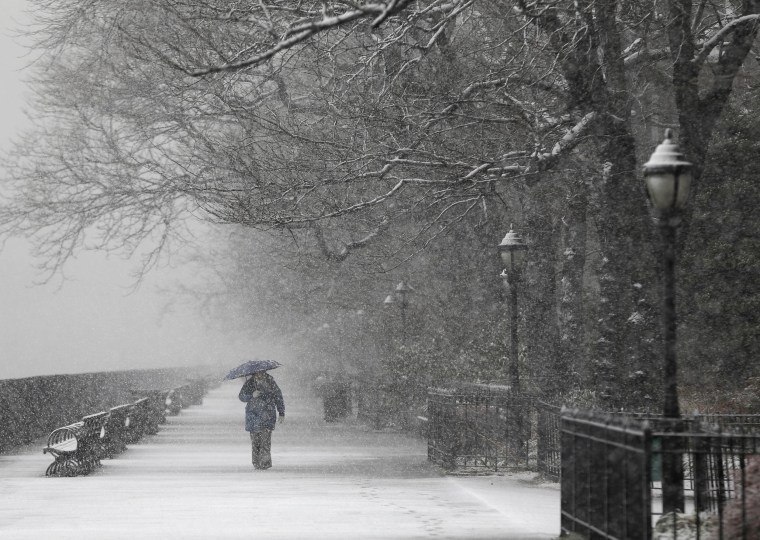The extreme cold and snow across the eastern half of the United States this past winter makes global warming seem laughable. But, paradoxically, the blasts of polar air were fueled in part by planet-warming gases, according to a new paper.
In particular, the gases helped plow heat into the tropical western Pacific Ocean that, in turn, drove the jet stream further north toward the Arctic before it funneled cold, snowy weather over the Midwest and East Coast, explained Tim Palmer, a climate physicist at the University of Oxford in the United Kingdom.
The sea surface temperatures in the western Pacific were "probably the warmest ever recorded this past year," he told NBC News. "In fact, consistent with that, we had these fantastically strong tropical typhoons in the western Pacific, not least Haiyan which broke all records of wind strength."
In addition to pounding the sea and land surface with wind and rain, typhoons and other tropical storms also release energy into the upper atmosphere. This energy, in turn, excites so-called Rossby waves in jet streams, the rivers of air that snake around the globe and produce weather patterns at the surface.
The extra stormy weather in the tropical western Pacific generated extra-large waves in the Northern Hemisphere jet stream, positioning it to send cold weather to the eastern United States, according to Palmer.
The theory, outlined today in the journal Science, builds on research Palmer conducted in the 1980s and resonates with more recent work led by Kevin Trenberth, a climate scientist at the National Center for Atmospheric Research in Boulder, Colo.
"Everything he has got here is fine," Trenberth told NBC News after reviewing the paper, adding that the connection between the cold winter and climate change can be made even stronger by quantifying the warming waters and storminess in the tropical western Pacific.
Warm waters pile up
The build-up of heat in the tropical western Pacific has also been tied to another head scratcher in climate science: the apparent pause, or hiatus, in surface temperature warming since the major El Niño winter of 1997-98.
During an El Niño, east-to-west trade winds collapse or reverse, allowing warm waters from the tropical western Pacific to dissipate along the equator toward South America, which influences weather patterns around the world. For example, heavy rains often fall on California and drought hits Australia.
Since the late 1990s, the east-to-west trade winds have "gotten stronger and more persistent than normal and what this has been doing is piling warm water up in the western Pacific," Palmer said.
These winds have essentially blown the excess heat generated under continued greenhouse warming into the deep layers of the ocean, according to recent research on the surface warming hiatus.
"My speculation is that that has led to a couple tenths of a degree on top of this already very, very warm water that is being piled up by the trade winds," Palmer said. "So, we've gotten, in my view, a kind of subtle interaction between natural climate variability and man-made climate change."
This interaction led to locally devastating tropical cyclones and amplified waves in the jet stream enough to account for this past winter's record cold in the United States and record wet weather in the United Kingdom, he added.
Arctic influence?
Pinning the cold weather on interactions between global warming and natural variability in the tropical western Pacific carries more clout than a controversial hypothesis that the winter chill was driven by rapid warming in the Arctic, Trenberth noted.
According to that theory, advanced by Jennifer Francis at Rutgers University in New Brunswick, New Jersey, the Arctic is warming faster than the rest of the globe, which in turn has caused the northern polar jet stream to become wavier. Some of those bigger bends in the jet stream bring cold Arctic air further south, which could also explain the winter chill in the eastern United States.
That theory is controversial, explained Palmer, mostly because the Arctic is considered too small of an area to have a major influence on global weather patterns. In addition, what happens at the surface in the Arctic — which is definitely warming — stays at the surface unlike the western Pacific where heat from tropical storms is released to the upper atmosphere where it influences the jet stream.
Francis noted in an email to NBC News that precipitation in the tropical western Pacific has been consistently strong for the past seven years, including the winter of 2011-2012 when the eastern United States had an exceptionally warm winter.
"Because the tropical rainfall patterns in these two years were very similar but the temperature extremes in the two winters in the U.S. were opposite, the tropical pattern cannot be the only reason for the persistent cold spell this winter," she said.
"I cannot say that rapid Arctic warming played a role in either of these unusual winters in the U.S.," she added, "but the very amplified (wavy) jet stream during both years is consistent with the sorts of patterns we expect to occur more frequently as the Arctic continues to warm."
Cold winters on their way out?
According to Palmer's research, cold winters will overall become rarer as the concentration of greenhouse gases increases in the atmosphere and the planet continues to warm.
"In fact, I'm sort of expecting in the near future they will probably become much less common because all evidence suggests we are heading into an El Niño year when all of this warm water that was previously piled up in the western Pacific will flow back across the Pacific," he said.
If that is indeed the case, he added, the hiatus too will likely come to an end and "global mean temperatures will start to rise at the rate that they were doing back in the early 1990s."
